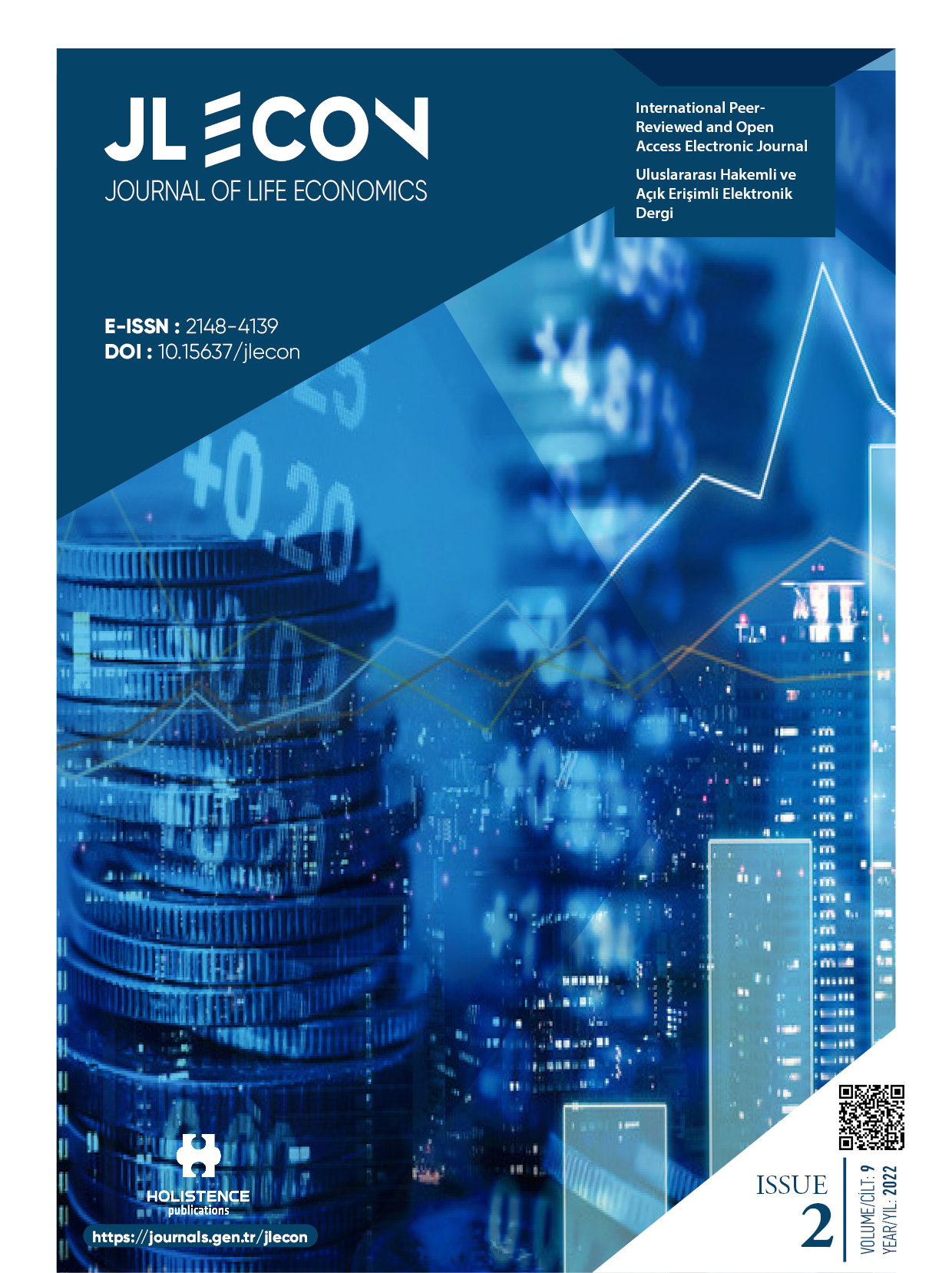Testing the middle income trap for upper middle income countries by fourier cointegration
DOI:
https://doi.org/10.15637/jlecon.9.2.04Anahtar Kelimeler:
Middle income trap- Fourier ADF Unit Root Test- Fourier ADL Cointegration TestÖzet
The middle income trap is defined as the inability to rise to a higher income group after the gross domestic product value reaches the middle income level and is stuck in a certain income range. Based on this point, the data used in the study covers the period 1960-2019. The middle income trap hypothesis was tested for upper middle income country groups in 2019 and has been included in the 22 countries included in the study. The per capita Gross Domestic Product data for the mentioned countries and the reference country were obtained from the World Bank database. In the study, in order to perform the Banerjee Arcabic Lee (2017) Fourier ADL cointegration test, the variables used in the analysis should be first-order I (1) stationary. For this reason, before the cointegration test, Ng-Perron Test (2001), Enders and Lee (2012) Fourier Function Stationarity Test, Christopoulos and Leon Ledesma (2010) Fourier CSR Stability tests were performed to determine the stationarity levels of variables. And then the Banerjee Arcabic Lee (2017) Fourier ADL cointegration test was applied to the above mentioned 16 countries. According to the results of Fourier ADL Cointegration, the null hypothesis, which asserts that there is no cointegration for Botswana, Brazil, China, Colombia, Ecuador, Fiji, Gabon, Guatemala, Iran, Jamaica, Malaysia, Peru, South Africa, Suriname, Trinidad and Tobago, including Turkey cannot be rejected within 5% significance level. Therefore, empirical evidence has been obtained that these countries are in the middle income trap.
İndirmeler
Referanslar
BANERJEE, P.,ARABİC, V.and LEE, H. (2017). Fourier ADL Cointegration Test to Approximate Smooth Breaks with New Evidence from Crude Oil Market. Economic Modelling, 67/C, pp.114-124.
BOZKURT, E. , BEDİR, S. , ÖZDEMİR, D. and ÇAKMAK, E. (2014). Orta gelir tuzağı ve Türkiye örneği. Maliye Dergisi, 167, pp.22-39.
BOZKURT, E. , SEVİNC, H. and ÇAKMAK, E. (2016). Orta Gelir Tuzağı: Üst Orta Gelirli Ülkeler Üzerine Panel Veri Analizi. Ege Academic Review, 16(2).
CAİ Fang (2012). Is There A Middle Income Trap? Theories, Experiences And Relevance To China. China & World Economy, Vol: 20(1), pp. 49-61.
CHRİSTOPOULOS, D. K. And M. A. León-LEDESMA, Smooth Breaks and Non-Linear Mean Reversion: Post-Bretton Woods Real Exchange Rates, Journal of International Money and Finance, 2010, 29(6), pp.1076-1093.
DALGIÇ, B. , İYİDOĞAN, P. V. and BALIKÇIOĞLU, E. (2014). Orta Gelir Tuzağından Çıkışta Hangi Faktörler. Maliye Dergisi, 167, pp.116-125.
ENDERS, W. and LEE, J. (2012a). A unit root test using a Fourier series to approximate smooth breaks. Oxford Bulletin of Economics and Statistics, 74(4), pp. 574-599.
ENDERS, W. and LEE, J. (2012b), The flexible Fourier form and Dickey– Fuller type unit root tests. Economics Letters, 117(1), pp.196-199.
FELİPE, J. , ABDON, A. and KUMAR, U. (2012). Tracking The Middleincome Trap: What Is It, Who Is İn It, And Why?. Working Paper No. 715. New York: Levy Economics Institute.
GİLL, Indermit S. and G. KHARAS (2007). An East Asian Renaissance: Ideas For Economic Growth. The World Bank 1(39986):1-365.
HEPSAĞ, A. (2019). Orta Gelir Tuzağı Hipotezine Asimetrik Doğrusal Olmayan Koentegrasyon Yaklaşımı. Uluslararası Akademik Araştırmalar Kongresi, pp. 244-253.
HEPSAĞ, A. (2019). Testing For Cointegration İn Nonlinear Asymmetric Smooth Transition Error Correction Models. Communications İn Statistics-Simulation And Computation, pp. 1-13.
HOMI K. and HARINDER K. (2011). What Is The Middle Income Trap, Why Do Countries Fall İnto It, And How Can It Be Avoided? . Global Journal Of Emerging Market Economies.
İLHAN, A and AKDENİ̇Z, C. (2020). Orta Gelir Tuzağının Türkiye Geneli ve Düzey Alt Bölgeleri İçin Tespiti. Optimum Ekonomi ve Yönetim Bilimleri Dergisi, 7 (1) , pp.253-278.
JANKOWSKA, A. , NAGENGAST, A. and PEREA, J. R. (2012). The Product Space And The Middleincome Trap: Comparing Asian And Latin American Experiences, Working Paper No. 311. Paris: Oecd Development Center.
KASA, H. (2019). Orta Gelir Tuzağı: Dinamik Panel Veri Analizi. Tesam Akademi Dergisi, Türkiye Ekonomisi Özel Sayısı, pp.153-182.
LUDLOW, J. and ENDERS, W. (2000). Estimating Non-Linear ARMA Models Using Fourier Coefficients. International Journal of Forecasting, 16(3), pp. 333-347.
NG, S. and PERRON, P. (2001). Lag Length Selection and the Construction of Unit Root Tests with Good Size and Power. Econometrica, 69,pp.1529–1554.
ÖZTÜRK, A. C. (2019). Orta Gelir Tuzağına Doğrudan Yabancı Yatırımların Etkisi, Türkiye Değerlendirmesi ”. İstanbul T.C. Maltepe Üniversitesi Sosyal Bilimler Enstitüsü, İktisat Ana Bilim Dalı, Doktora Tezi, Şubat 2019
ROBERTSON, P. E. and YE, L. (2013). On the Existence of a Middle Income Trap, University of Western Australia Economics Discussion Paper 13.12.
RODRIGUES, P. M. & TAYLOR, A. M. R. (2012), The Flexible Fourier Form and Local Generalised Least Squares De‐trended Unit Root Tests. Oxford Bulletin of Economics and Statistics, 74(5),pp. 736-759.
SARIBAŞ, H., & URSAVAŞ, U. (2017). Orta Gelir Tuzağı: Ampirik Bir Çalışma. Abant İzzet Baysal Üniversitesi Sosyal Bilimler Enstitüsü Dergisi, 17(2), pp. 37-51.
TEKİN, İ. (2018). Türkiye'de işsizlik histerisi: Fourier fonksiyonlu durağanlık sınamaları. Dokuz Eylül Üniversitesi İktisadi İdari Bilimler Fakültesi Dergisi, 33(1),pp. 97-127.
THO, T. V. (2013). The Middle-Income Trap: Issues For Members Of The Association Of Southeast Asian Nations , Vnu Journal Of Economics And Business, 29(2),pp.107-128.
UĞURLU, E. (2009). Durağanlık Ve Birim Kök Sınamaları. İstanbul Aydın Üniversitesi Ekonomi ve Finans Bölümü (Ders Notları), 1-17.
ÜNLÜ, F. and YILDIZ, R. (2018). Orta Gelir Tuzağinin Belirleyicileri: Diskriminant Analizi. Atatürk Üniversitesi İktisadi Ve İdari Bilimler Dergisi, 32 (1) ,pp.45-64.
YILDIZ, A. (2015). Orta Gelir Tuzaği Ve Orta Gelir Tuzağından Çıkış Stratejileri. Fırat Üniversitesi Sosyal Bilimler Dergisi, 25 (2), pp.155-170.
İndir
Yayınlanmış
Nasıl Atıf Yapılır
Sayı
Bölüm
Lisans
Telif Hakkı (c) 2022 Jolistence Publications

Bu çalışma Creative Commons Attribution 4.0 International License ile lisanslanmıştır.
Yazarlar, makale Journal of Economics'te yayınlanmak üzere kabul edildiğinde .makalenin içeriğindeki tüm telif haklarını, Holistence Publications'a devrederler. Yazarlar, patent hakları gibi telif hakkı dışındaki tüm mülkiyet haklarını saklı tutar.
Bu makalede yazar olarak listelenen herkes çalışmaya önemli, doğrudan, entelektüel katkılar yapmış olmalı ve bunun için kamu sorumluluğu almalıdır.
Bu makale daha once yayınlanmamış ve başka dergilerde yayınlanmak üzere gönderilmemiştir.













